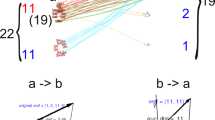Abstract
When a language adapts words from another language, the adapting language (L1) naturally tries to retain the phonemic contrasts of the source language (L2). However, if the L2 has a greater degree of contrast than the L1 then either the extra degree(s) of contrast will be lost, or the L1 must introduce markedness into its phonological system. The objective of this article is twofold
First, I argue that the introduction of markedness into the L1’s phonology when adapting words from another language correlates with the social relationship between the languages. I demonstrate this by examining the retention of phonemic contrast in the various stages of the adaptation of Chinese words into Japanese
Second, I argue for a phonological constraint that enforces the retention of L2’s phonemic contrast, DISTINCT. An Optimality Theoretic analysis of the adaptation of Sino-Japanese produces the expected results for all of stages of adaptation except one—the stage when contact between the two languages is at its peak. For this stage, the analysis requires the addition of the DISTINCT constraint
Similar content being viewed by others
References
Baxter W. (1994). A handbook of old Chinese phonology. Mouton de Gruyter, Berlin
Bentley J. (2001). A descriptive grammar of early old Japanese prose. Brill, Leiden
Clements G.N., Hume E. (1995) Internal organization of speech sounds. In: Goldsmith J. (eds). The handbook of phonological theory. Blackwell Publishers, Oxford, pp. 245–306
Ding, Q. (1981). Chūgoku Kotoba no Zatsugaku [Various Notes on the Chinese Language], Kōhō Kikaku Centre, Tokyo
Flemming, E. (1995). Auditory representations in phonology. PhD dissertation, University of California, Los Angeles
Itô J., Mester A. (1994) Reflections on CodaCond and alignment. In: Merchant J., Padgett J., Walker R. (eds). Phonology at Santa Cruz 3. University of California, Santa Cruz: Linguistics Researcher Center, pp. 27–46
Itô J., Mester A. (1995). The core-periphery structure of the lexicon and constraints on reranking. In: Beckman J., Walsh-Dickey L., Urbanczyk S. (eds). University of Massachusetts occasional papers in linguistics 18: Papers in optimality theory. GLSA, Amherst, pp. 181–209
Itô J., Mester A. (1996) Stem and word in Sino-Japanese. In: Otake T., Cutler A. (eds). Phonological structure and language processing: Cross-linguistic studies. Mouton de Gruyter, Berlin, pp. 13–44
Itô J., Mester A. (2000) The phonological lexicon. In: Tsujimura N. (eds). The handbook of Japanese linguistics. Blackwell Publishers, Oxford, pp. 62–100
Jacobs H., Gussenhoven C. (2000) Loan phonology: Salience, the lexicon and optimality theory. In: Dekkers J., van der Leeuw F., van de Weijer J. (eds). Optimality theory: Phonology, syntax, and acquisition. Oxford University Press, Oxford, pp. 193–210
Kager R. (1999) Optimality theory. Cambridge University Press, Cambridge
Karlgren B. (1954). Compendium of phonetics in Ancient and Archaic Chinese, reprinted from Bulletin of the Museum of Far Eastern Antiquities 26:211–367
Kishida T. (1998). Kokugo On’in Henka Ron [A theory of the phonological change of Japanese]. Musashino Shoin, Tokyo
Kurisu K. (2000). Richness of the base and root fusion in Sino-Japanese. Journal of East Asian Linguistics 9:147–185
LaCharité D., Paradis C. (1997). Preservation and minimality in loanword adaptation. Journal of Linguistics 33:379–430
Lange R. (1973) The phonology of eighth-century Japanese. Sophia University, Tokyo
Loveday L. (1996) Language contact and Japan—a socio-linguistic history. Clarendon Press and Oxford University Press, New York
Lubowicz, A. (2003). Contrast in phonological mappings. PhD dissertation, University of Massachusetts, Amherst
Martin S. (1987) The Japanese language through time. Yale University Press, New Haven
McCarthy J., Prince A. (1995) Faithfulness and reduplicative identity. In: Beckman J., Benua L., Urbanczyk S. (eds). University of Massachusetts occasional papers in linguistics 18: Papers in optimality theory. GLSA, Amherst, pp. 249–384
McCawley J. (1968). The phonological component of grammar. Mouton, The Hague
Miller R. (1967) The Japanese language. The University of Chicago Press, Chicago
Numoto, K. (1986). Nihon Kanji’on no Rekishi [The history of Japanese Kanji readings]. Tōkyōtō, Tokyo
Padgett J. (2003). Contrast and post-velar fronting in Russian. Natural Language and Linguistic Theory 21:39–87
Paradis C. (1988). On constraints and repair strategies. The Linguistic Review 6:71–97
Paradis C., Prunet J.-F. (2000) Nasal vowels as two segments: Evidence from borrowings. Language 76:324–357
Pulleyblank E. (1984) Middle Chinese—a study in historical phonology. University of British Columbia Press, Vancouver
Pulleyblank E. (1991) Lexicon of reconstructed pronunciation in Early Middle Chinese, Late Middle Chinese and Early Mandarin. University of British Columbia Press, Vancouver
Shibatani M. (1990) The languages of Japan. Cambridge University Press, Cambridge
Silverman D. (1992). Multiple scansions in loanword phonology: Evidence from Cantonese. Phonology 9:289–328
Shitanaka K. (eds) (1980) Sekai Chizuchō [World atlas]. Heibonsha, Tokyo
Syromiatnikov N. (1981) The Ancient Japanese language, translated by Y N Filippov. Nauka Publishing House, Moscow
Wardhaugh R. (1998) An introduction to sociolinguistics (3rd ed). Blackwell Publishers, Oxford
Yip M. (1993) Cantonese loanword phonology and optimality theory. Journal of East Asian Linguistics 2:261–91
Yoshitake S. (1934) The phonetic system of Ancient Japanese. The Royal Asiatic Society, London
Author information
Authors and Affiliations
Corresponding author
Additional information
I thank Edwin Pulleyblank, Ken Takashima, Elan Dresher, Keren Rice, Peter Avery, the two anonymous JEAL reviewers, and the participants of the Phonology Group at the University of Toronto and the MOT Phonology Conference 2002 for helpful comments. An earlier version of this work appeared in Toronto Working Papers in Linguistics, Vol. 21, University of Toronto, Toronto, pp. 27–42.
Rights and permissions
About this article
Cite this article
Heffernan, K. The role of phonemic contrast in the formation of Sino-Japanese. J East Asian Linguist 16, 61–86 (2007). https://doi.org/10.1007/s10831-006-9007-8
Received:
Revised:
Accepted:
Published:
Issue Date:
DOI: https://doi.org/10.1007/s10831-006-9007-8




